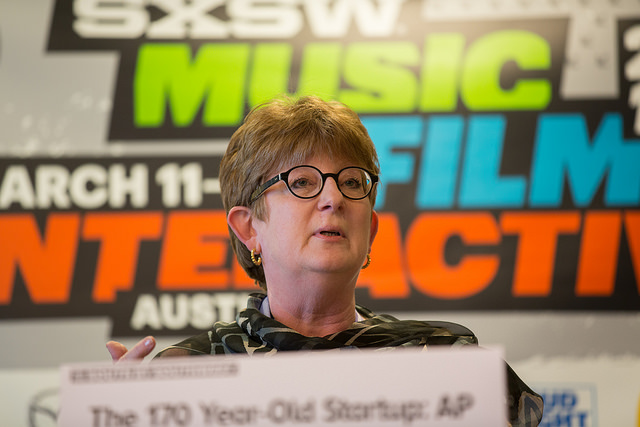Insights from SXSW on the Rise of the Customer and the Importance of User Experience
This year marked my second visit to SXSW Interactive. Along with hundreds of session choices, were a plethora of activities – amazing comedians, long lines, musicians, film panels, free swag galore, and also a little visit from the President and First Lady of the United States(!). Since it’s impossible of course to attend every event, it seemed a better bet to find a personal takeaway – and mine, as a Senior Experience Designer in the field of User Experience Design, was focused on the topic of empathy for customers within the digital space. This was discussed in detail at SXSW, in all sorts of different ways.
A bit of background: I’ve been a User Experience Designer focusing mainly on transactional interfaces for over a decade, and have practiced many methods of gaining customer insight. My mantra has been one of tirelessly advocating for “customer needs first, and business results will follow.” However, when there is a conflict, customer research findings should trump any politics getting in the way of what a customer needs to accomplish within an interface.
Many organizations laid claim to UX or being “user-centric” years ago simply because it was a needed buzzword, but I’ve seen plenty make that claim and never so much as glanced at customer comments. So it’s still an evolving profession that’s only begun to truly be taken seriously in some corners of the industry recently…but it’s finally happening.
In fact, headlines coming from the Forrester’s and Gartner’s of the world are more frequently echoing sentiments that customer experience is the new business battleground for market share. Which brings me back to the main point of this article. Much to my happiness, SXSW Interactive reinforced all of these sentiments through a call for deep customer empathy.
A Quote from SXSW: “Judge Less & Design More”
The empathy trend started with a session presented by Jennifer Briselli of Oakland, CA-based design agency MadPow, where she discussed methods of talking with users on often divisive topics like climate change and gun control. Jennifer began her session stating, “Start with Empathy.”
She stressed that it’s important to understand your own values first, so you have an understanding of how your own beliefs could potentially influence customer discussions. Furthermore, it’s crucial to note that empathy does not equal endorsement. Her lessons were important for the field of UX design. Without this empathy, customer research (and life in general), won’t yield the best conversations. It’s critical to truly relate to others’ beliefs from as an objective standpoint as possible, without judgment. She concluded her session with a powerful sentiment: “Judge Less. Design More.”
Leveraging Customer Needs to Shape Your Process
Elizabeth Rosenzweig’s session entitled Getting It Right used a very old school — yet still relevant — image of nineteenth-century plate cameras that required a cart and donkey to haul, in contrast to the portable Kodak camera developed soon after, which she coined as “the mobile device of 1888.” This invention was a great example for Rosenzweig to use, because it was a ground-breaking simplification of a process that decided to take into account empathy for consumers and ease of use – while, of course, opening up photography to the masses.
Rosenzweig used this photography scenario to illustrate her examples, concluding with the need to identify the highest priority customer needs. She then mapped the best tools to obtain feedback about those needs – including focus groups, usability testing, surveys, and persona development.
The key message here: customize your process around customer need. Many of us have a concrete scope of work defined before we begin talking to or even thinking about customers, which simply is not the right approach. It’s increasingly important for UX designers to help shape project plans so that we’re not circumscribed by cookie-cutter methods and deliverables that aren’t answering the right questions. An example: don’t conduct a usability study if you’re trying to understand customer motivations.
Takeaway: My advice, if you don’t have a seat at the project definition table, is to advocate for yourself professionally to get that seat, build ties with solution architects and those at the forefront of sales, and demonstrate how you can achieve better results if you use methods that DO answer the right questions. Above all, let customer need drive your process.
Using “Nudges” to Address Customer Needs
The next stop on the empathy tour was a workshop entitled Nudges: Tiny Pushes That Influence User Behavior, presented by Devin O’Bryan and Russell Parrish of IBM. The focus of this workshop was the ability to understand customer decision-making rationales in order for companies to develop “Nudges” that influence user behavior.
The process started out similar to a persona- or journey-mapping process: i.e. talk to your customers; understand who they are demographically, their needs, and their pain points during the stages when they may interact with a given organization (online and off). The stages were rooted in six universal experiences:
-
-
- Discover, try and buy
- Getting started
- Productive use of the product or service
- Management and upgrading
- Extending usage
- Getting support
-
From there, an empathy map was created based on what the persona is thinking, feeling, and doing at each of these stages. In this case, the example was a woman in her late twenties considering life insurance. Some of her pain points were surrounding confusion regarding the need for life insurance (“I don’t know if I even really need this”), and worry that insurance agents play on her fears (“they don’t have my best interests in mind”).
From those pain points, UI solution design comes into play by designing “Nudges,” intended to be an expanding library of user needs and concerns, coupled with approaches to help solve them. For example, during the Discover, Try and Buy phase, it would be important to include a Nudge for Displaying Authority to build confidence in the agent’s credibility. Another example of a Nudge would be to Create Contrast by offering tiered services. And the person who is on the fence about the need for life insurance need may be enticed to buy if an entry-level product were available.
The team at IBM is building a library of “Nudges” geared toward UX designers now scheduled to be released in late 2016. This should prove to be a great resource for UX designers, since it will introduce the concept of patterns that we’ve seen abundantly in industry, but with the empathetic twist of UI examples specifically as they relate to helping alleviate and address customers’ emotional concerns.
The Presidential Keynote
President Barack Obama’s address was one of the highlights of SXSW because it marked the first time a sitting president had appeared in SXSW’s 30-year history. The President focused heavily on user-friendliness of digital services and access concerns, citing that “we’re the only advanced democracy in the world that makes it harder for people to vote,” and he further added that it is “easier to order a pizza than to vote.”
He then called upon those in the audience shaping the tech environment to engage in civic participation and apply their knowledge and skills to tackling the big issues – inviting participation in the activities of the relatively new US Digital Service. This was created in response to the difficulties with HealthCare.gov and is touted as “teams of problem-solvers making government services simple, effective, and efficient.” Their goal, again, is rooted in empathy for citizens by striving to make critical services as simple as buying a book online.
Strategically Elevating UX – And Now It’s Your Turn
So, the end Takeaway: Organizations of all sizes (all the way to The White House!) are sending the message that empathy must be a leading factor across technology and user interface solutions.
If you’re not already in a strategic UX position that has the support to advocate and advance customer needs on your projects, it’s time to work toward getting a seat at that table. Evangelize the value of customer research and empathy in whatever forums you can, and use your empathy to break down silos to build alliances with diverse departments that work with customers (sales, customer service, product management), plus those involved in project definition and build (IT, development teams, project management, and many others).
Personally, on the last three major projects I’ve worked on, development teams have been more engaged and excited to collaborate on interfaces than I’ve ever seen. They’re also eager to make the experience better for customers. Partnership and collaboration will only help strengthen solutions for our customers and further elevate the field of UX as the strategic endeavor we all know it to be.
Written by: Nancy McCrave, Sr Experience Designer
Feature Photo: Kathleen Carroll, Executuve Editor/SVP, Associated Press
6 Effective Communication
Effective Communication Women Making History
Women Making History Grants & Funding Sources
Grants & Funding Sources Interview Prep
Interview Prep Impactful Leadership
Impactful Leadership Dressing for Work
Dressing for Work Dressing for Your Style
Dressing for Your Style Interview Style Tips
Interview Style Tips Women's Stocking Stuffers
Women's Stocking Stuffers Gift the Busy Traveler
Gift the Busy Traveler Airport Layover Activities
Airport Layover Activities Traveling & Eating Healthy
Traveling & Eating Healthy Travel Like a Boss Lady
Travel Like a Boss Lady The Dual California Life
The Dual California Life Gifts for Thanksgiving
Gifts for Thanksgiving Summer Reading List
Summer Reading List Top Leisurely Reads
Top Leisurely Reads New Year, New Books
New Year, New Books Life Lessons from a Sitcom
Life Lessons from a Sitcom Oprah, Amy or Amal?
Oprah, Amy or Amal?






